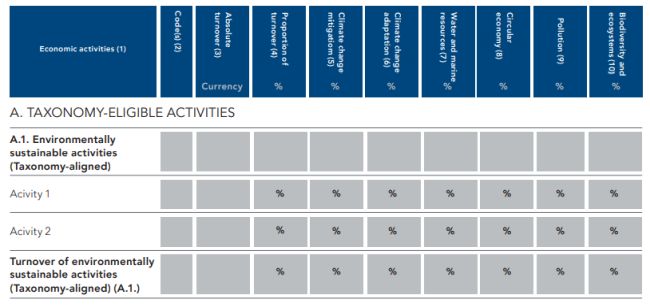What is a taxonomy anyway?
The EU's "Taxonomy" is a classification framework that determines whether an economic activity is environmentally sustainable.
Under EU legislation, "large" EU companies will soon need to report on their taxonomy "alignment" as part of their mandatory sustainability disclosures. This means, at risk of oversimplifying, reporting on the extent to which the activities of their business corresponds to what the EU views as "environmentally sustainable".
This catches a lot of large subsidies of US and other international businesses. It is likely to be a complicated exercise for many businesses, and one that they have not had to undergo before.
Says who?
The taxonomy itself is established by the Taxonomy Regulation. It requires certain entities to disclose how, and to what extent, the undertaking's activities are "environmentally sustainable", within the meaning of the Taxonomy.
What entities and how soon?
The most relevant requirement for international businesses with operations in the EU is for "large" EU entities to report for the first time in 2025, in respect of their activities in 2024. The term "large" applies to a company or, where that company is a parent of a consolidated group, a group meeting two of the following tests:
- balance sheet total exceeding EUR 20 million;
- net turnover exceeding EUR 40 million; and
- more than 250 employees.
There are specific requirements for banks, insurers and financial institutions that we haven't reported on.
So what will the reporting look like?
Ultimately, regulators will expect to see a table that looks a bit like this:

OK, so how do I get started?
Unfortunately, there is no single, consolidated, document that sets out how to go about working out your taxonomy alignment. The table at the end of this alert sets out some of the key documents. We have set out high-level overview of the process below.
What activities performed by my company might be covered by the Taxonomy?
The six environmental objectives of the Taxonomy are:
- Climate change mitigation
- Climate change adaptation
- Sustainable use and protection of water and marine resources
- Transition to a circular economy
- Pollution prevention and control
- Protection and restoration of biodiversity and ecosystems.
For an activity to be "environmentally sustainable" then four criteria must be met. The activity must:
- Contribute "substantially" to at least one of six environmental objectives
- Do no significant harm to any of the other objectives
- Do no significant harm to any of the other objectives
- Respect basic labour standards.
How do I work out if I contribute to climate change mitigation, etc?
Technical screening criteria
This is where is starts to get more complicated. A painstaking process has been undertaken to develop the "technical screening criteria" that answer this question. These are set out in what are called "delegated acts". The first to be published set out the screening criteria if you are hoping that the activities of your company are fully or partly aligned with the objective of "climate change mitigation" and / or "climate change adaptation".
Climate Delegated Act
You can look at Annex 1 to the "Climate Delegated Act" to see what activities are capable of being aligned with the "climate change mitigation" requirements of the Taxonomy. There are over a hundred pages of specifications in respect of different activities.
Taking an example, "Manufacture of low carbon technologies for transport" is specified, along with the technical criteria for falling within this category. These include, for example, the economic activities of manufacturing, repairing, maintaining, retrofitting, repurposing or upgrading trains, passenger coaches and wagons that have zero direct (tailpipe) CO2 emissions.
Environmental Delegated Act
Annexes 1 through 4 of the "Environmental Delegated Act" (not yet published in the Official Journal and so not yet in force) set out what activities are cable of contributing to the "other" objectives, (sustainable use and protection of water and marine resources, transition to a circular economy, pollution prevention and control, and protection and restoration of biodiversity and ecosystems).
As an example, under Annex 1, "Manufacture, installation and associated services for leakage control technologies enabling leakage reduction and prevention in water supply systems" is specified, together with details of the detailed requirements relating to how to determine whether your activities fall within this category.
Do no significant harm
The Delegated Acts also set out the tests for "doing no significant harm". For example, in respect of "Manufacture of low carbon technologies for transport", vehicles must not contain lead, mercury, hexavalent chromium and cadmium (in accordance with Directive 2000/53/EC) and certain "generic" requirements (also set out in Appendices) must also be adhered to.
Are there any "social" requirements?
As regards respecting basic human rights and labour standards, the Taxonomy sets out high level information on the minimum safeguards that companies need to comply with in order for their activities to be considered to be taxonomy aligned.
The activity must be carried out in alignment with the OECD Guidelines for Multinational Enterprises and UN Guiding Principles on Business and Human Rights, including the eight fundamental International Labour Organisation conventions and the International Bill of Human Rights.
From a practical perspective, companies will need to identify the procedures in place to ensure compliance with the relevant governance standards and social norms.
This is another challenging aspect of the legislation and one of which little guidance is available. The October 2022 report of the Platform on Sustainable Finance on minimum safeguards gives some guidance to companies to navigate how these provisions can be applied in practice.
In any event, EU businesses will soon be confronted with mandatory requirements to carry our environmental and human rights due diligence, which should assist in ensuring that these requirements are met. See our article here.
What if I am misaligned?
Don't worry, it happens to the best of us. As the Commission says in its FAQ document, "There are several reasons why a company might not have economic activities that are aligned with the criteria of the EU Taxonomy: its economic activities might simply not be covered by the EU Taxonomy, or it may be covered but not make a substantial contribution to an environmental objective; or it might make a substantial contribution but not meet the do no significant harm criteria or the minimum social safeguards ... not having Taxonomy-aligned activities does not, in itself, reveal the company's exact environmental performance".
Enabling & Transitional Activities
Also, all is not necessarily lost. "Enabling" and "transitional" activities have been added to the Taxonomy to allow activities which may not otherwise have been considered environmentally sustainable to contribute to the overall objective of promoting sustainability.
"Enabling" activities are ones which allow other activities to make a substantial contribution to one or more of the Taxonomy's objectives. They must have a substantial positive environmental impact over the activity's lifecycle and cannot lead to a "lock-in" of assets which would undermine long-term environmental goals.
"Transitional" activities must contribute to climate change mitigation and a pathway to keeping global warming in line with Paris Agreement commitments. They can only be applicable where there are no technologically or economically feasible low-carbon alternatives, where GHG emissions levels correspond to the best performance in the sector or industry and they do not lead to carbon lock-in or hamper the development and deployment of low-carbon alternatives.
So what are the relevant documents?
Unfortunately, there are may of them. At the risk of over-simplification, here is a high-level summary (with links to the underlying documents):
| Document | Purpose |
| Taxonomy Regulation | Sets out the high-level framework for the Taxonomy |
| Article 8 / "Disclosures" Delegated Act | Specifies the content methodology and presentation of information to be presented |
| Climate Delegated Act | Defines the technical screening criteria for economic activities that make a substantial contribution to climate change mitigation and adaptation as well as the "do no significant harm" criteria for other objectives |
| Environmental Delegated Act | Defines the technical screening criteria for economic activities that make a substantial contribution to other objectives (not climate change mitigation and adaptation) as well as the "do no significant harm" criteria for other objectives |
| User Guide | A high-level user guide to the Taxonomy |
| EU Taxonomy Compass | An online tool that allows users to search for activities within the Taxonomy and the applicable screening criteria |
| EU Taxonomy Calculator | An online tool that allows users to enter financial information to help determine taxonomy alignment |
What about the ESRS?
The Taxonomy is also relevant to your (separate) requirements to comply with Corporate Sustainability Reporting Directive (CSRD) (see our publication here). Under the CSRD, you will have to report in accordance with the relevant ESRS. These also include references to the Taxonomy. For example, "Disclosure Requirements E1-1 - Transition plan for climate change mitigation", requires disclosure of "if applicable, an explanation of the undertaking's objective for aligning its economic activities (revenues) with the [Taxonomy] ... and its plans for future Taxonomy alignment (revenues, CapEx and CapEx plans)."
What about the UK?
The UK is in the process of developing its own taxonomy and disclosure requirements.
Originally published by 09 October, 2023
Visit us at mayerbrown.com
Mayer Brown is a global services provider comprising associated legal practices that are separate entities, including Mayer Brown LLP (Illinois, USA), Mayer Brown International LLP (England & Wales), Mayer Brown (a Hong Kong partnership) and Tauil & Chequer Advogados (a Brazilian law partnership) and non-legal service providers, which provide consultancy services (collectively, the "Mayer Brown Practices"). The Mayer Brown Practices are established in various jurisdictions and may be a legal person or a partnership. PK Wong & Nair LLC ("PKWN") is the constituent Singapore law practice of our licensed joint law venture in Singapore, Mayer Brown PK Wong & Nair Pte. Ltd. Details of the individual Mayer Brown Practices and PKWN can be found in the Legal Notices section of our website. "Mayer Brown" and the Mayer Brown logo are the trademarks of Mayer Brown.
© Copyright 2023. The Mayer Brown Practices. All rights reserved.
This Mayer Brown article provides information and comments on legal issues and developments of interest. The foregoing is not a comprehensive treatment of the subject matter covered and is not intended to provide legal advice. Readers should seek specific legal advice before taking any action with respect to the matters discussed herein.











